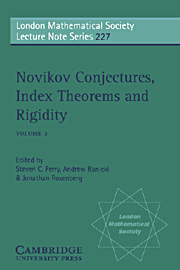Book contents
- Frontmatter
- Contents
- Contents, Volume 1
- Preface, The Editors
- Research and Survey Papers
- Proper affine isometric actions of amenable groups
- Bounded K-theory and the assembly map in algebraic K-theory
- On the rigidity of the index on open manifolds
- Remarks on Steenrod homology
- Epsilon surgery theory
- On the coarse Baum-Connes conjecture
- Exotic index theory and the Novikov conjecture
- Bounded and continuous control
- On the homotopy invariance of the boundedly controlled signature of a manifold over an open cone
- 3-manifolds and PD(S)-groups
- Orthogonal complements and endomorphisms of Hilbert modules and C*-elliptic complexes
- Assembly
Assembly
Published online by Cambridge University Press: 07 May 2010
- Frontmatter
- Contents
- Contents, Volume 1
- Preface, The Editors
- Research and Survey Papers
- Proper affine isometric actions of amenable groups
- Bounded K-theory and the assembly map in algebraic K-theory
- On the rigidity of the index on open manifolds
- Remarks on Steenrod homology
- Epsilon surgery theory
- On the coarse Baum-Connes conjecture
- Exotic index theory and the Novikov conjecture
- Bounded and continuous control
- On the homotopy invariance of the boundedly controlled signature of a manifold over an open cone
- 3-manifolds and PD(S)-groups
- Orthogonal complements and endomorphisms of Hilbert modules and C*-elliptic complexes
- Assembly
Summary
Abstract. The goal of assembly is to approximate homotopy invariant functors from spaces to spectra by homotopy invariant and excisive functors from spaces to spectra. We show that there exists a best approximation, characterized by a universal property.
The Ordinary Assembly Map
We adopt a very category theoretic point of view in describing assembly maps. It has been formulated explicitly by Quinn in the appendix to [Q], and more implicitly in Quinn's thesis, in [QGF], in [And] and in articles of Waldhausen, e.g. [Wai], [Wa2]. See also [QAB]. Prom this point of view, the goal of assembly is: Given a homotopy invariant functor F from spaces to spectra, to approximate F from the left by an excisive homotopy invariant functor F%.
In this section, all spaces are homotopy equivalent to CW–spaces, all pairs of spaces are homotopy equivalent to CW–pairs, and all spectra are CW –spectra.
A functor F from spaces to spectra is homotopy invariant if it takes homotopy equivalences to homotopy equivalences. A homotopy invariant F is excisive if F(θ) is contractible and if F preserves homotopy pushout squares (alias homotopy cocartesian squares, see [Gol], [Go2]). The excision condition implies that F preserves finite coproducts, up to homotopy equivalence. Call F strongly excisive if it preserves arbitrary coproducts, up to homotopy equivalence.
If F is strongly excisive, then the functor π*F from spaces to graded abelian groups is a generalized homology theory—it has Mayer–Vietoris sequences, and satisfies the strong wedge axiom.
- Type
- Chapter
- Information
- Novikov Conjectures, Index Theorems, and Rigidity , pp. 332 - 352Publisher: Cambridge University PressPrint publication year: 1995
- 22
- Cited by

